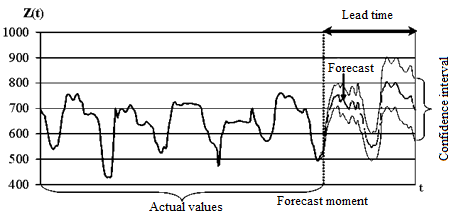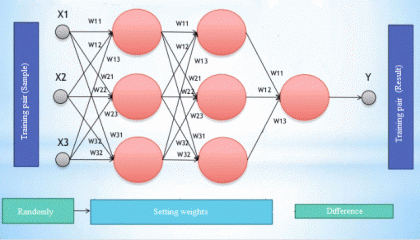Abstract
Сontent
- Introduction
- 1. Theme urgency
- 2. Goal and tasks of the research
- 3. The mathematical formulation
- 4. Application of genetic algorithms for training neural networks
- Conclusion
- References
Introduction
The stock market is a very important and separate place in the modern economy [1]. Its scope includes both credit relations and relations of co-ownership, expressed in terms of the issue of special instruments (securities), which have their own value and can be sold, bought and redeemed.
The stock market is characterized by the volume and structure of transferable securities, the speed of circulation, price movement, dynamics rate securities, the degree of investment risk, a measure of openness of information, the number and volume of stock transactions committed the level of profitability of the securities and transactions with them[2]. Securities – a special product that appeals to the market and reflects the property relations. Securities can buy, sell, assign, pledge, store, transfer, inheritance, gift and exchange [2].
With the help of a well-functioning securities market it is possible to reallocate funds between branches flexibly, to concentrate them on the most promising areas of scientific and technological progress, i.e. to accelerate and optimize the structural shifts in the economy.
1. Theme urgency
The securities market is the most accessible source of financing growth [3]. It facilitates access to all economic entities to obtain the necessary financial resources. In the period of stable economic development, there are occasions when the prices of major stakes change dramatically in a short period of time. In order to predict the behavior of price movements on the securities market perform prediction stock market indicators. With the help of a well-functioning securities market funds can be flexibly reallocated between branches, concentrated on the most promising areas of scientific and technological progress i.e. accelerated and optimized the structural shifts in the economy.
Such a task is urgent, as the prediction is a necessary element of any investment activity, because the idea of investing – investing money to generate income in the future – is based on the idea of predicting the future [4].
2. Goal and tasks of the research
The purpose of research is to develop methods to predict the dynamics of price indices in the stock market for effective decision to invest in a particular sector of production and reduce investment risk using evolutionary techniques, which will increase speed of results and their accuracy.
To achieve this goal it is necessary to perform the following tasks:
- Domain analysis, existing methods and models to predict and package applications.
- To identify factors influencing the change in price indices.
- Determining the neural network topology.
- The development of a learning algorithm.
- Check the accuracy of the model and determine its effectiveness.
Research object: behavior of the dynamics of price indices in the stock market.
Research subject: predicting the dynamics of price indices in the stock market by using combined modeling and forecasting techniques.
3. The mathematical formulation
Price indices are time series in discrete time t = 1,2, ..., T. The values of previous price indexes are as follows Z (t) = Z (1), Z (2), ..., Z (T). At time T necessary to determine process values Z (t) at time T +1, T +2, ..., T + R. Time T is called the moment of the forecast, and the value of P – lead time (the time by which you want to make a prediction).
1. To calculate the values of the time series at a future time it is required to determine the functional dependence, reflecting the link between past and future values of the series
(1)
This relationship is called forecasting model. Want to create a forecasting model, for which the mean absolute deviation from the true value of the minimum projected aims for a given P.
(2)
2. Addition of future values of Z (T +1), ..., Z (T + P) is required to determine a confidence interval of possible values of these deviations.The problem of forecasting of the price index is illustrated in figure 1 [9].
Figure 1 – Graphic formulation of the problem
4. Application of genetic algorithms for training neural networks
In the theory of neural networks, there are two pressing problems, one of which is the choice of the optimal structure of neural network and the other one is the construction of an efficient algorithm for neural network training.
The process of training the neural network is to configure the network so that for some set of inputs to give the desired (or at least close it ordained) multiple outputs.
Figure 4 – The method of the inverse error propagation
Figure 4 shows the process of training a neural network with a "teacher" using back-propagation algorithm [11].
However, this algorithm inherent disadvantages[12]:
- the possibility of a premature stop falling due to a local minimum;
- the necessity of multiple – presentation of all the training set to obtain the desired quality of recognition;
- the absence of any acceptable ratings training time.
The problems associated with the back-propagation algorithm led to the development of alternative methods of calculating the weights of neural networks.
The idea that neural networks can be trained by using a genetic algorithm , was expressed by various researchers. The first work on this topic dealt with the application of genetic algorithm as a method of teaching small unidirectional neural networks [12], but later realized it was the application of this algorithm for networks with larger dimension [13].
As a rule, the task is to optimize the weights of the neural network, with a priori given topology. First in 1989, David Montana and Lawrence Davis used genetic algorithms as means of adjusting the weights of hidden and output layers for a fixed set of connections [14]. Weights are encoded as binary sequences (chromosome). Each individual population is characterized by a complete set of weights of the neural network. Evaluation of fitness of individuals is determined by fitness function, defined as the sum of squared errors, i.e. differences between the expected (reference) and actually received values at the output of the network for different input data[15].
(3)
The initial population is randomly selected, the weights are in the interval [ -1.0, 1.0]. For training network to the initial population, simple operations are used: selection, crossover, mutation, and as a result, new populations are generated .
Conclusion
The studies proposed a method of forecasting models using neural networks and genetic algorithms that will provide more accurate and timely data in a short period of time, as genetic algorithms provide a global view of the space scales and help avoid local minima. Also identified the main problems that must be solved to achieve this goal. Was briefly described to research and developed a mathematical formulation of the problem. An analysis of the use of economic forecasting models and identified strengths and weaknesses of the models considered.
References
- Жуков Е.Ф. Рынок ценных бумаг / Жуков Е.Ф. // М.:Юнити-Дата, 2009. – C. 14.
- Бердникова Т.Б. Рынок ценных бумаг и биржевое дело / Бердникова Т.Б. // М.:Инфра-М, 2002. – C. 9 – 100.
- Арефьева Н.Н. Банковское право: учеб. пособие / Арефьева Н.Н., Волкова И.А., Карабанова К.И., Лясина С.Ю., Редреева Т.О., Травкин А.А. // Волгоград: ВолГу, 2001. – C. 604.
- Демин А. В. Логико-вероятностные методы прогнозирования и распознавания нарушений динамики финансовых временных рядов / Демин А. В. // Молодой ученый № 11 (58). – Казань, 2013. – C. 41.
- Система прогнозирования NeuroProphesier [Electronic resource] – Access mode: www.ambler-soft.ru.
- Energy4Cast–Система прогнозирования цен [Electronic resource] – Access mode: www.forecsys.ru.
- Index4Cast [Electronic resource] – Access mode:http://www.e-mastertrade.ru/ru/main/index/id18.asp.
- Stock4Cast [Electronic resource] – Access mode:http://www.e-mastertrade.ru/ru/main/index/id23.asp.
- Чуева И. А. Модель прогнозирования временных рядов по выборке максимального подобия: диссертация [Electronic resource] / Чуева И. А. – Москва, 2012. – Access mode:www.mbureau.ru.
- Энциклопедия производственного менеджера – Методы прогнозирования [Electronic resource] – Access mode:www.up-pro.ru.
- Дюк В. Data Mining: учебный курс / Дюк В., Самойленко А. – СПб: Питер, 2001. – 386 с.
- Whitley D., Applying genetic algorithms to neural network learning, Proceedings of the Seventh Conference of the Society of Artificial Intelligence and Simulation of Behavior, Sussex, England, Pitman Publishing, 1989, pp. 137 – 144.
- Schaffer J. D., Whitley L, Eshelman J., Combinations of Genetic Algorithms and Neural Networks: A Survey of the State of the Art, Proceedings of International Workshop on Combinations of Genetic Algorithms and Neural Networks. COGANN-92, 1992.
- Melanie Mitchell. An Introduction to Genetic Algorithms. Massachusetts Institute of Technology, 1998. – С. 280.
- Рутковская Д. Нейронные сети, генетические алгоритмы и нечеткие системы / Рутковская Д., Пилиньский М., Рутковский Л. / Пер. с польск. И. Д. Рудинского // – М.: 2006. – С. 276.


